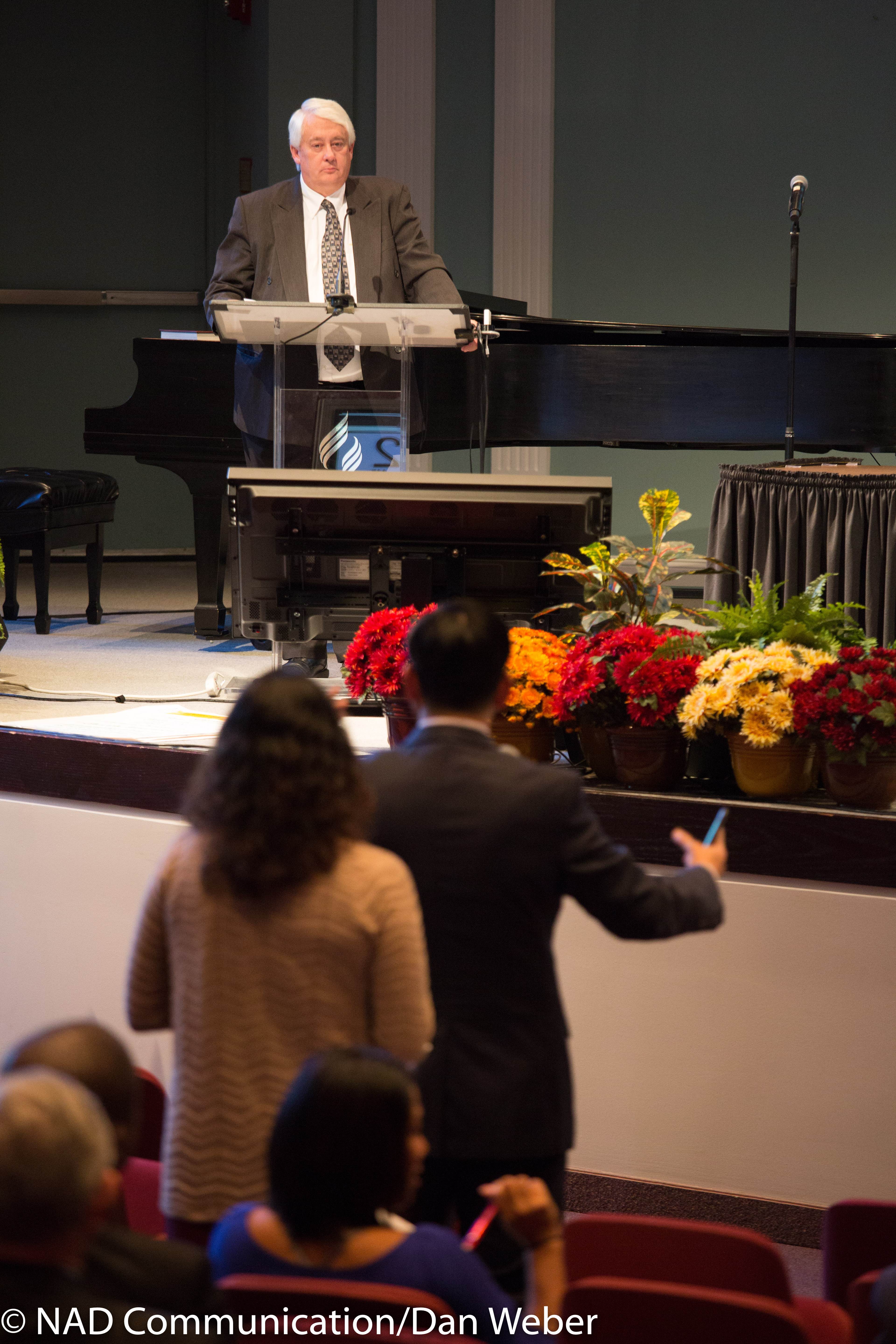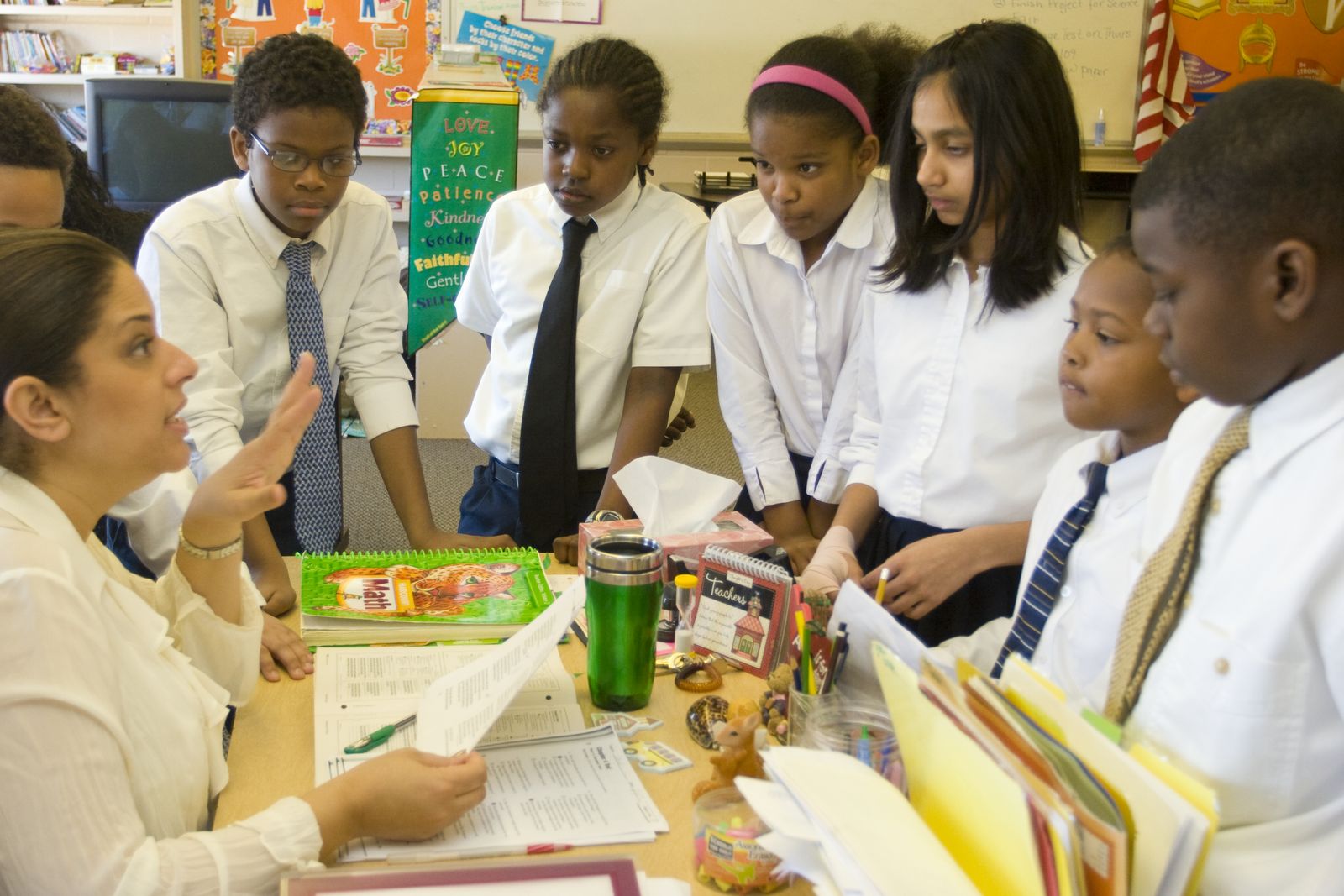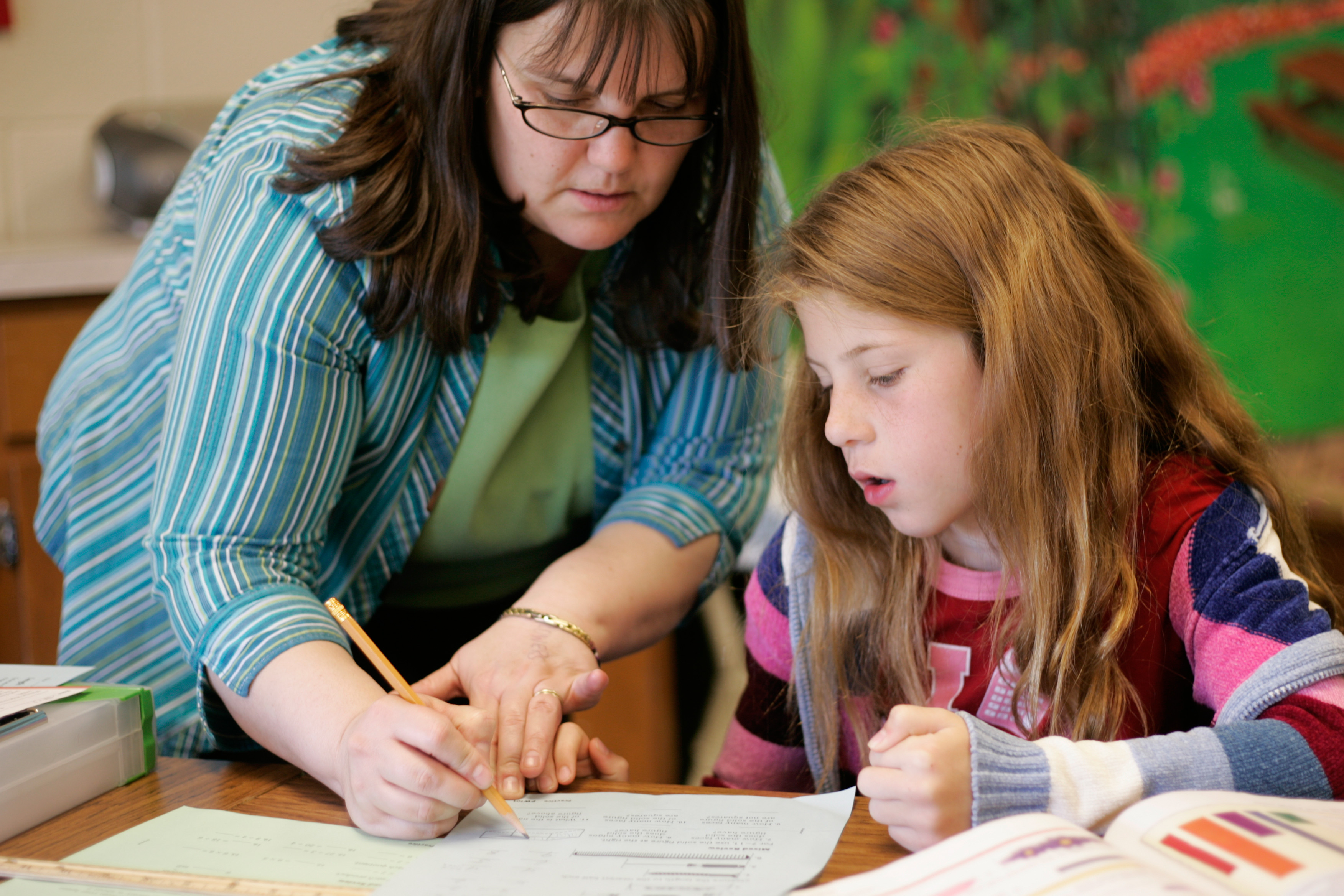Eight recommendations geared toward bringing the ecclesiastical and educational sides of the Adventist Church together for mission are voted at the 2016 NAD Year-End Meeting.
Three special committees, or taskforces, created in 2014 at the historic Dulles meetings, gave follow-up reports that included recommendations up for vote at the 2016 North American Division (NAD) Year-End Meeting. The NAD Education Taskforce (NADET) was tasked with discovering ways of Advancing Christian Education in North America. Larry Blackmer, vice president for Education for the Seventh-day Adventist Church in North America, explains the significance of the voted recommendations in the interview below.
Kimberly Luste Maran/NAD Communication: Give us a brief history of the committee.
Larry Blackmer addresses the NAD Executive Committee during the 2016 NAD Year-End Meeting. Photo by Dan Weber
Larry Blackmer: [NAD president] Dan Jackson called a meeting of all the division administrators in Dulles, Virginia, in May 2014. The open agenda asked: What are the issues in the church that need to be addressed in the next quinquennium? Out of that came three major initiatives: one on the mission of the church — mission effectiveness — one on the structure of the church, and one on education.
We asked Elissa Kido, the author of the CognitiveGenesis research to be the chair. I was vice-chair and secretary. After a year of work we came to the 2015 NAD YEM with 18 recommendations. The NAD Executive Committee voted their top five preferences.
We took those recommendations and enhanced them. We also added finance. We started with about 30 different topics that the committee deemed important. We began to find out what was important, grouping them into areas. We ended up with eight different topics in the 2016 report.
Please describe the topics.
The eight topics are the importance of mission of Adventist education; collaboration between pastors and educators; finances (financial stability); school quality and accountability (systems); leadership development; school personnel quality and accountability (including teacher/professional development); distance learning — extending the reach of Adventist education through distance education; and marketing and public relations. It took almost a year to get it down to those eight.
Who was part of the committee?
Last year, we had a group of about 20 on the taskforce and then there were another 50 on what we called a resource team. We’d send our ideas to that team and get feedback so that we were connecting to the field. When we moved to eight different recommendations, and this year particularly in finance, we knew we had to reconfigure our membership a bit to put more finance people on — and to put more distance education people on the committee — to strengthen the areas we knew we were going to work on.
While many of the people who were part of the original committee stayed on, we have added more pastors, and we’ve endeavored to make sure the committee is ethnically diverse.
In 2016, we had about nine GoToMeeting and two face-to-face meetings. We looked at first of all boiling down to find out what the major topics were. Then we built subcommittees on those areas. And those subcommittees then worked and brought recommendations back to the full committee.
Quite a bit of research was conducted.
There is extensive research — research that we did — and also something called SAE, which is Strengthening Adventist Education, from Andrews University. Research professors Anneris Coria-Navia and Jerome Thayer interviewed 27 different people across the division in many different areas: administrators from conferences, unions, and the division, pastors, teachers, parents, etc. And they did both group interviews and individual interviews.
The researchers also conducted 16 focus groups with 184 educators and 108 officers.
Which recommendations are you most excited about? And which ones do you think might be most challenging?
I was absolutely amazed that we got the buy in from the leadership of the division that we did on the entire document. There was only one minor tweak made by the executive committee.
I am pleased that the leadership of the church is taking Seventh-day Adventist education seriously. We've had a divide that has grown between the ecclesiastical side of the church and education over the past 20 years. . . . Not with any malice — I think it was just benign neglect since education back then was doing very well.
The first recommendation is on mission — how we then reengage the ecclesiastical side back to the educational system. We have one mission: the whole idea of the church is to make sure everyone knows Jesus and has a personal relationship with Him. We want students to have a strong academic environment, and a safe environment, where they know Jesus as their personal Savior within the context of the Adventist church. And so that's what we're trying to bring out in this document and in our trying to merge the school and church back together again.
Sligo Seventh-day Adventist School (Takoma Park, Md.) students listen to their teacher during class. Photo by Larry Blackmer
The second largest issue is pastor and pastor-teacher relationships. The pastor is the gatekeeper. And we found out that 60 percent of the seminary students are second career individuals. They've had no little or no background in Adventist education. Therefore, you have these seminary students, many of them self-sponsored, who were not getting any subsidy when they got to the seminary to send their own kids to Seventh-day Adventist education. And currently there are no classes on Adventist education in the seminary. There's only an elective for youth ministry.
So when those pastors leave the seminary we send them to a three-church district with a struggling church school and we hold them accountable to tithe and membership growth. That's their rubric for success. But this little church school over here on the side has 10 students and is taking 60 percent of their combined budget. They see the church school as the antithesis of them being able to be successful. In order to be successful they have to get rid of the church school so they have the finances to do evangelism and church growth so that they can be deemed successful by those who are holding them accountable.
We have this whole system that works against the small schools — we've closed 274 schools in 15 years. Most of them are small schools; and many of them are traceable back to this issue.
What if we were to combine the church and the school so the pastor was intimately involved in the school, not in administration but in support, in ministry? And we made the teacher and the pastor partners in ministry? That is the second recommendation.
A teacher assists a student at Village Adventist Elementary School in Berrien Springs, Mich. Photo by Larry Blackmer
How could this recommendation become reality?
I spoke to Jiří Moskala, from the Seventh-day Adventist Theological Seminary, about courses on Adventist education. He asked, “What do you think if we were to have a required course in the seminary on Adventist education?"
I said, "That's great."
He added, "Also we think that every pastor ought to do a field school and actually do time in a school in which they observe how to partner in ministry with the teacher. Every single pastor would spend two weeks in a school.”
I told him that would be fantastic, and asked how we could make it happen.
He answered: "I've already been to my faculty and we voted it."
So right after NAD YEM, I went to the seminary and actually began to work on the curriculum, and began the search committee to hire a full-time professor to do Adventist education at the seminary starting August 2017. This is a long-term fix; it's a systemic change.
If we could strengthen our partnership with pastors . . . this isn’t a one-way street. Educators also need to be engaged in their local church. And too many pastors say, “You know I haven't seen the principal in a year. They haven't darkened the door of my church in a year.”
I have a saying: I like to fly fish. And I made a decision a few years ago. It was tough, but I finally made the decision to never again fish in the swimming pool. Why?
There's nothing to catch.
Spirituality is caught, not taught. Spirituality — teachers and preachers have to have something to catch. It has to be infectious. We can teach religiosity, but spirituality is caught. And so it's really important that we help our teachers and preachers have something to catch. And if that is something they worked on together then it's doubly infectious because they catch it at the church and they catch it at the school.
And, hopefully, the parents buy in and the students catch it at the home. ValueGenesis* tells us if you have those three items working together it's like 86 percent more effective in the faith development of children than any one by itself.
You mentioned training for pastors and teachers in order to work together to accomplish the mission. Are there any other ways to help Adventist education be more successful?
Distance education and systemness. I think both of those are important — If we pull together like the franchise model. When you go to McDonalds you know what to expect.
There ought to be aspects of Adventist education that are this way. The curriculum ought to be solid curriculum. If you go to an Adventist school this is the curriculum that you know you're going to get. If you go there you know you're going to get friendly faculty who care about your children.
Systemness is pulling together, in the same direction, all schools, pastors, and teachers — building a system that ensures some basic standards in all schools. And systemness isn’t just for our brick and mortar schools. We have to build a strong distance education program too.
We have about 12 distance learning programs across the division. We need to have one centralized, division-sponsored, and low-cost distance education program for K-12. We're not there yet, but that's the goal. And that brings me to one of my biggest burdens:
We have 30 percent of our children in Adventist education.
That’s more than twice any other denomination in this country, but that’s still a terrible number for us — that leaves 70 percent out there.
Pathfinders is great, but they aren’t talking about Adventist beliefs such as the sanctuary . . . and families aren't talking about it at home because we've already lost the generation who are raising their children on the sanctuary and other core messages we have in the church. So there's no place for these kids to learn those foundational church values. We're going to lose another generation if we don't do something.
We have the 30 percent plus the 70 percent, which we define as the 100 percent. But I also want to redefine the 100 percent to include those “mission appropriate” children in our community who we should also be caring about and worrying about.
We have to redefine the 100 percent to the larger 100 percent of the community: mission appropriate children in our community. NADET has created a special taskforce, the North American Division All Children’s Taskforce (NADACT) to develop something for the 70 percent and for the larger 100 percent. We have to build that base, that missional base in all of our children.
And so we’ve made this recommendation. The NADET committee reaffirmed this as did the NAD executive committee. Although this wasn’t a specific part of our report, NADACT could be counted as recommendation nine, if you will.
How do you define mission appropriate?
That's a term that I've coined during the past 20 years. I’ve often said we need to have all mission appropriate children in our schools. There are Seventh-day Adventists that are not mission appropriate — they don't believe in the values of the church and they don't believe in upholding the teacher. Or they may have severe learning disabilities that we cannot handle within the school.
But then there are those outside of our faith community who really buy in even deeper than some of our own. They're more supportive of the school, more supportive of the values and the safe environment.
The point is that we have to know what our mission is before we can tell whether somebody is mission appropriate. And that's what we're trying to get Adventist education to do — redefine the mission. To reemphasize the value of that mission, and operationalize that mission within the school.
Only then can we determine whether someone is mission appropriate.
What does it mean for the future of Adventist education that the executive committee for North America endorsed these recommendations?
We’ve turned a corner to some degree — now we're all on the same page saying that education is vital to the success of the Adventist Church. After our presentation we’ve talked about other business — tithe and spending — and I’ve heard this said during those sessions: "We need to make sure we protect education. We cannot let education get hurt in this process."
We're going to remarry the ecclesiastical side with the educational side and begin to work together in the mission. It's not us and them. We’re in this together.
* ValueGenesis is a research study into the faith and values of youth attending Seventh-day Adventist high schools in North America in the three areas of family, school and church. The first survey was conducted in 1990, a second survey was conducted in 2000, and the third survey was conducted in 2010.



